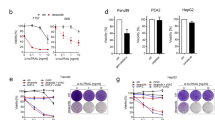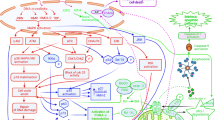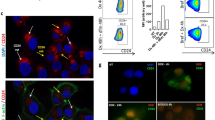Abstract
The appearance of multidrug-resistant (MDR) proteins or the acquisition of a defective apoptotic programme are major drawbacks in the treatment of cancers since both induce a resistance to classical chemotherapy. However, a link between the two mechanisms has not, as yet, been clearly established. In this study, HL-60 cells cultured in the continual presence of a sub-lethal dose of doxorubicin (dox; HL-60/Dox) were used as a model to study acquired chemoresistance. During the induction of chemoresistance, the appearance of a functional P-glycoprotein (P-gp), in addition to the expression of anti-apoptotic Bcl-2, Bcl-XL and pro-apoptotic Bax proteins was assessed. Parental cells which are sensitive to dox, have no P-gp activity and express Bcl-2 and Bax. After 4 weeks of treatment, a functional P-gp was detected in HL-60/Dox cells. In addition, the synthesis of Bcl-2 appeared to be replaced by Bcl-XL while that of Bax remained unchanged. These cells were also resistant to apoptosis induced by both P-gp and non-P-gp substrates. This inability to induce apoptosis could have resulted from the induction of the expression of the inhibitor of apoptosis protein (XIAP). Our data show that acquired chemoresistance could involve a parallel induction of P-gp and an impairment of the apoptotic pathway.
This is a preview of subscription content, access via your institution
Access options
Subscribe to this journal
Receive 12 print issues and online access
$259.00 per year
only $21.58 per issue
Buy this article
- Purchase on Springer Link
- Instant access to full article PDF
Prices may be subject to local taxes which are calculated during checkout








Similar content being viewed by others
References
Hannun YA . Apoptosis and the dilemma of cancer chemotherapy Blood 1997 89: 1845–1853
Bellamy WT, Dalton WS, Dorr RT . The clinical relevance of multidrug resistance Cancer Invest 1990 8: 547–553
Huang Y, Ibrado AM, Reed JC, Bullock G, Ray S, Tang C, Bhalla K . Co-expression of several molecular mechanisms of multidrug resistance and their significance for paclitaxel cytotoxicity in human AML HL-60 cells Leukemia 1997 11: 253–257
Smyth MJ, Krasovskis E, Sutton VR, Johnstone RW . The drug efflux protein, P-glycoprotein, additionally protects drug-resistant tumor cells from multiple forms of caspase-dependent apoptosis Proc Natl Acad Sci USA 1998 95: 7024–7029
Legrand O, Simonin G, Beauchamp-Nicoud A, Zittoun R, Marie J-P . Simultaneous activity of MRP1 and Pgp is correlated with in vitro resistance to daunorubicin and with in vivo resistance in adult acute myeloid leukemia Blood 1999 94: 1046–1056
Ino T, Miyazaki H, Isogai M, Nomura T, Tsuzuki M, Tsuruo T, Ezaki K, Hirano M . Expression of P-glycoprotein in de novo acute myelogenous leukemia at initial diagnosis: results of molecular and functional assays, and correlation with treatment outcome Leukemia 1994 8: 1492–1497
Kasimir-Bauer S, Ottinger H, Meusers P, Beelen DW, Brittinger G, Seeber S, Scheulen ME . In acute myeloid leukemia, coexpression of at least two proteins, including P-glycoprotein, the multidrug resistance-related protein, Bcl-2, mutant p53, and heat-shock protein 27, is predictive of the response to induction chemotherapy Exp Hematol 1998 26: 1111–1117
Johnstone RW, Cretney E, Smyth MJ . P-glycoprotein protects leukemia cells against caspase-dependent, but not caspase-independent, cell death Blood 1999 93: 1075–1085
Pallis M, Russell N . P-glycoprotein plays a drug-efflux-independent role in augmenting cell survival in acute myeloblastic leukemia and is associated with modulation of a sphingomyelin-ceramide apoptotic pathway Blood 2000 95: 2897–2904
Lepage P, Gros P . La glycoprotéine P: de la résistance croisée aux médicaments au transport des lipides biliares Méd/Sciences 1995 11: 357–366
Simonian PL, Grillot DAM, Nunez G . Bcl-2 and Bcl-XL can differentially block chemotherapy-induced cell death Blood 1997 90: 1208–1216
Minn AJ, Rudin CM, Boise LH, Thompson CB . Expression of Bcl-XL can confer a multidrug resistance phenotype Blood 1995 86: 1903–1910
Liu R, Page C, Beidler DR, Wicha MS, Nunez G . Overexpression of Bcl-XL promotes chemotherapy resistance of mammary tumors in a syngeneic mouse model Am J Pathol 1999 155: 1861–1867
Wickremasinghe RG, Hoffbrand AV . Biochemical and genetic control of apoptosis: relevance to normal hematopoiesis and hematological malignancies Blood 1999 93: 3587–3600
Gross A, McDonnell JM, Korsmeyer SJ . BCL-2 family members and the mitochondria in apoptosis Genes Dev 1999 13: 1899–1911
Chao DT, Korsmeyer SJ . BCL-2 family: regulators of cell death Annu Rev Immunol 1998 16: 395–419
Lowe SW, Lin AW . Apoptosis in cancer Carcinogenesis 2000 21: 485–495
Liu X, Kim CN, Yang J, Jemmerson R, Wang X . Induction of apoptotic program in cell-free extracts: requirement for dATP and cytochrome c Cell 1996 86: 147–157
Li P, Nijhawan D, Budihardjo I, Srinivasula SM, Ahmad M, Alnemri ES, Wang X . Cytochrome c and dATP-dependent formation of Apaf-1/caspase-9 complex initiates an apoptotic protease cascade Cell 1997 91: 479–489
Nicholson DW . Caspase structure, proteolytic substrates, and function during apoptotic cell death Cell Death Differ 1999 6: 1028–1042
Kluck RM, Bossy-Wetzel E, Green DR, Newmeyer DD . The release of cytochrome c from mitochondria: a primary site for Bcl-2 regulation of apoptosis Science 1997 275: 1132–1136
Yang J, Liu X, Bhalla K, Kim CN, Ibrado AM, Cai J, Peng TI, Jones DP, Wang X . Prevention of apoptosis by Bcl-2: release of cytochrome c from the mitochondria blocked Science 1997 275: 1129–1132
Miyashita T, Reed JC . Bcl-2 oncoprotein blocks chemotherapy-induced apoptosis in a human leukemia cell line Blood 1993 81: 151–157
Tu Y, Renner S, Xu F-H, Fleishman A, Taylor J, Weisz J, Vescio R, Rettig M, Berenson J, Krajewski S, Reed JC, Lichtenstein A . BCL-X expression in multiple myeloma: possible indicator of chemoresistance Cancer Res 1998 58: 256–262
Han Z, Chatterjee D, Early J, Pantazis P, Hendrickson EA, Wyche JH . Isolation and characterization of an apoptosis-resistant variant of human leukemia HL-60 cells that has switched expression from Bcl-2 to Bcl-XL Cancer Res 1996 56: 1621–1628
Amundson SA, Myers TG, Scudiero D, Kitada S, Reed JC, Fornace AJ . An informatics approach identifying markers of chemosensitivity in human cancer cell lines Cancer Res 2000 60: 6101–6110
Kojima H, Endo K, Moriyama H, Tanaka Y, Alnemri ES, Slapak CA, Teicher B, Kufe D, Datta R . Abrogation of mitochondrial cytochrome c release and caspase-3 activation in acquired multidrug resistance J Biol Chem 1998 273: 16647–16650
Pallis M, Zhu Y-M, Russell NH . Bcl-XL is heterogeneously expressed by acute myeloblastic leukemia cells and is associated with autonomous growth in vitro and with P-glycoprotein expression Leukemia 1997 11: 945–949
Deveraux QL, Reed JC . IAP family of proteins-suppressors of apoptosis Genes Dev 1999 13: 239–252
Deveraux QL, Takahashi R, Salvesen GS, Reed JC . X-linked IAP is a direct inhibitor of cell-death proteases Nature 1997 388: 300–304
Deveraux QL, Leo E, Stennicke HR, Welsh K, Salvesen GS, Reed JC . Cleavage of human inhibitor of apoptosis protein XIAP results in fragments with distinct specificities for caspases EMBO J 1999 18: 5242–5251
Duckett CS, Li F, Wang Y, Tomaselli KJ, Thompson CB, Armstrong RC . Human IAP-like protein regulates programmed cell death downstream of Bcl-XL and cytochrome c Mol Cell Biol 1998 18: 608–615
Marie JP, Huet S, Faussat AM, Perrot JY, Chevillard S, Bardu V, Bayle C, Boutonnat J, Calvo F, Compos-Guyotat L, Colosetti P, Cazin JL, de Cremoux P, Delvincourt C, Demur C, Drenou B, Fenneteau O, Feuillard J, Garnier-Suillerot A, Genne P, Gorisse MC, Gosselin P, Jouault H, Lacave R, Le Calvez G, Léglise MC, Léonce S, Manfait M, Maynadié M, Merle-Béral H, Merlin JL, Mousseau M, Morjani H, Picard F, Pinguet F, Poncelet P, Racadot E, Raphael M, Richard B, Rossi JF, Schlegel N, Vielh P, Zhou DC, Robert J . Multicentric evaluation of the MDR phenotype in leukemia. French network of the drug resistance intergroup, and drug resistance network of assistance publique-hopitaux de Paris Leukemia 1997 11: 1086–1094
Juin P, Pelletier M, Oliver L, Tremblais K, Grégoire M, Meflah K, Vallette FM . Induction of a caspase-3-like activity by calcium in normal cytosolic extracts triggers nuclear apoptosis in a cell-free system J Biol Chem 1998 273: 17559–17566
Johnstone RW, Ruefli AA, Smyth MJ . Multiple physiological functions for multidrug transporter P-glycoprotein? Trends Biochem Sci 2000 25: 1–6
Zhou P, Qian L, Kozopas KM, Craig RW . Mcl-1, a Bcl-2 family member, delays the death of hematopoietic cells under a variety of apoptosis-inducing conditions Blood 1997 89: 630–643
Ross DD . Novel mechanisms of drug resistance in leukemia Leukemia 2000 14: 467–473
Nussler V, Pelka-Fleischer R, Zwierzina H, Nerl C, Beckert B, Gieseler F, Diem H, Ledderose G, Sauer H, Wilmanns W . P-glycoprotein expression in patients with acute leukemia-clinical relevance Leukemia 1996 10: (Suppl. 3) S23–S31
Chaundary PM, Robinson IB . Expression and activity of P-glycoprotein, a multidrug efflux pump, in human hematopoietic stem cells Cell 1991 66: 85–92
Gottshalk AR, Boise LH, Thompson CB, Quintans J . Identification of immunosuppressant-induced apoptosis in murine B-cell line and its prevention by Bcl-x and not Bcl-2 Proc Natl Acad Sci USA 1994 91: 7350–7354
de la Coste A, Fabre M, McDonell N, Porteu A, Gilgenkrantz H, Perret C, Kahn A, Mignon A . Differential protective effects of Bcl-XL and Bcl-2 on apoptotic liver injury in transgenic mice Am J Physiol 1999 40: G702–G708
Veis DJ, Sorenson CM, Shutter JR, Korsmeyer SJ . Bcl-2-deficient mice demonstrate fulminant lymphoid apoptosis, polycystic kidneys, and hypopigmentated hair Cell 1993 75: 229–240
Motoyama N, Wang F, Roth KA, Sawa H, Nakayama K-l, Nakayama K, Negishi I, Senju S, Zhang Q, Satoshi F, Loh DY . Massive cell death of immature hematopoietic cells and neurons in Bcl-XL-deficient mice Science 1995 267: 1506–1510
Kaufmann SH, Karp JE, Svingen PA, Krajewski S, Burke PJ, Gore SD, Reed JC . Elevated expression of the apoptotic regulator Mcl-1 at the time of leukemic relapse Blood 1998 91: 991–1000
Deshmukh M, Kuida K, Johnson EM Jr . Caspase inhibition extends the commitment to neuronal death beyond cytochrome c release to the point of mitochondrial depolarisation J Cell Biol 2000 150: 131–143
Deveraux QL, Roy N, Stennicke HR, Van Arsdale T, Zhou Q, Srinivasula SM, Alnemri ES, Salvesen GS, Reed JC . IAPs block apoptotic events induced by caspase-8 and cytochrome c by direct inhibition of distinct caspases EMBO J 1998 17: 2215–2223
Pan G, O'Rouke K, Dixit VM . Caspase-9, Bcl-XL, and Apaf-1 form a ternary complex J Biol Chem 1998 273: 5841–5845
Hu Y, Benedict MA, Wu D, Inohara N, Nunez G . Bcl-XL interacts with Apaf-1 and inhibits Apaf-1-dependent caspase-9 activation Proc Nat Acad Sci USA 1998 95: 4386–4391
Li F, Srinivasan A, Wang Y, Armstrong RC, Tomaselli KJ, Fritz LC . Cell-specific induction of apoptosis by microinjection of cytochrome c J Biol Chem 1997 272: 30299–30305
Acknowledgements
This study was sponsored by a grant from the ‘Le comité departemental de la Loire Atlantique de la Ligue Nationale contre le Cancer’ and the ‘Association pour la Recherche sur le Cancer, No.5402’. MC was a recipient of a grant from ‘La Ligue Nationale contre le Cancer’. We thank Pr R Bataille and Dr Ph Juin for critical reading of this manuscript. Pr Fumoleau and Dr Cuillière are thanked for their constant support throughout this project.
Author information
Authors and Affiliations
Rights and permissions
About this article
Cite this article
Campone, M., Vavasseur, F., Le Cabellec, M. et al. Induction of chemoresistance in HL-60 cells concomitantly causes a resistance to apoptosis and the synthesis of P-glycoprotein. Leukemia 15, 1377–1387 (2001). https://doi.org/10.1038/sj.leu.2402222
Received:
Accepted:
Published:
Issue Date:
DOI: https://doi.org/10.1038/sj.leu.2402222
Keywords
This article is cited by
-
Nanostructured Lipid Carriers: A potential drug carrier for cancer chemotherapy
Lipids in Health and Disease (2012)
-
Effects of permeability transition inhibition and decrease in cytochrome c content on doxorubicin toxicity in K562 cells
Oncogene (2006)
-
Constitutive presence of cytochrome c in the cytosol of a chemoresistant leukemic cell line
Apoptosis (2005)



